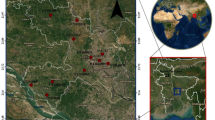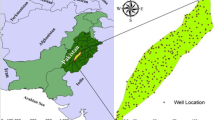Abstract
Groundwater data (water level, electrical conductivity (EC) and temperature) have been collected since 1995 from the national groundwater-monitoring stations in South Korea. Recently, substantial groundwater-level decline and deterioration of groundwater quality were reported at several stations. Relevant authorities undertook to investigate the groundwater hazards and to devise mitigation measures for selected monitoring stations. However, there were no criteria to determine the status of the groundwater level and EC, compared with historic data. A methodology is presented, which defines the groundwater condition. Using the suggested criteria, water level and EC data are classified into normal, watch and warning levels, leading to different administrative measures and technical investigations. The primary criterion compares the observed values for the evaluation year (e.g. 2003) and the historic values of normal years preceding the evaluation year (e.g. 1996–2002), using box plots. The secondary criterion uses variation trends of the values with the aid of parametric and non-parametric trend tests. Final decisions are dependent on scores assigned to each test. According to the criteria suggested, detailed investigations and mitigation measures for water level decline are required for seven stations and those for water quality are needed for 18 stations because they reside within the warning classification.
Résumé
Des données hydrogéologiques (niveau piézométrique, conductivité électrique (CE) et température) ont été collectées depuis 1995 à partir du réseau national de stations de surveillance des eaux souterraines de la Corée du Sud. Récemment, une baisse substantielle du niveau de l’eau souterraine et une détérioration de la qualité de l’eau ont été signalées sur plusieurs stations de surveillance. Les autorités compétentes ont entrepris d’étudier les risques pour les eaux souterraines et de trouver des mesures de mitigation pour les stations de surveillance sélectionnées. Cependant, aucuns critères n’existaient permettant de déterminer le statut du niveau piézométrique et de la conductivité électrique en comparaison des données historiques. Une méthodologie est présentée et définie les conditions hydrogéologiques. A l’aide des critères proposés, les données de niveaux piézométriques et de conductivités électriques sont classées suivant les niveaux dits normaux, niveaux à surveiller et niveaux d’alerte, conduisant à poursuivre des mesures administratives et des investigations techniques différentes. Le premier critère compare, grâce à des boites à moustache, les valeurs observées pour les années d’évaluation (1996–2002 par exemple). Le deuxième critère utilise les tendances de variation des valeurs à l’aide de tests de tendance paramétriques et non paramétriques. Les décisions finales dépendent des résultats de chaque test. D’après les critère suggérés, sept stations nécessitent des mesures d’investigations détaillées et de mitigation pour la baisse du niveau d’eau, et 18 stations nécessitent des mesures pour la qualité de l’eau car elles se situent dans une zone classée en alerte.
Resumen
En las estaciones nacionales de aguas subterráneas de Corea del Sur, se han recogido datos de agua subterránea (niveles piezométricos, conductividad eléctrica (CE) y temperatura) desde 1995. Recientemente, se ha observado en algunas estaciones que el nivel de agua subterránea ha descendido sustancialmente y que se ha producido un deterioro de la calidad de la misma. Las autoridades competentes han decidido emprender la investigación de los riesgos en aguas subterráneas y tomar medidas de mitigación para estaciones seleccionadas. Sin embargo, no había criterio para determinar el estado del nivel piezométrico y la CE, comparados con los datos históricos. Se presenta una metodología que define las condiciones de las aguas subterráneas. Utilizando los criterios propuestos, los datos de nivel piezométrico y de CE se han clasificado como normales, en vigilancia o preocupantes, atendiendo a diferentes medidas administrativas e investigaciones técnicas. El criterio primario compara los valores observados para el año de evaluación (por ejemplo, 2003) y los valores históricos de años normales anteriores a este año de evaluación (por ejemplo, 1996–2002), mediante gráficos de caja. El criterio secundario utiliza tendencias de variación de los valores con la ayuda de tests de tendencias paramétricas y no paramétricas. Las decisiones finales dependen de los resultados asignados a cada test. De acuerdo con los criterios sugeridos, se necesitan investigaciones detalladas y medidas de mitigación para el descenso de los niveles en siete estaciones y lo mismo para la calidad del agua en 18 estaciones, que se encuentran en niveles preocupantes.










Similar content being viewed by others
References
Alley WM (1985) Palmer drought severity index as a measure of hydrologic drought. Water Resour Bull 21(1):105–114
Gilbert RO (1987) Statistical methods for environmental pollution monitoring. Reinhold, New York
Kendall MG (1975) Rank correlation methods. Griffin, London
Kim GB (2005) Nationwide monitoring and assessment of groundwater in Korea. PhD Thesis, School of Earth and Environmental Sciences, Seoul National University, Seoul, Korea
Kim JW, Lee JY, Yi MJ, Kim GB, Won JH, Lee KK (2007) Allocating local groundwater monitoring stations for South Korea using an analytic hierarchy process. Hydrogeol J 15:615–632
Kim NJ, Cho MJ, Woo NC (1995) Developing a national groundwater-monitoring network in Korea. Hydrogeol J 3:89–94
KOWACO (Korea Water Resources Corporation), KIGAM (Korea Institute of Geoscience and Mineral Resources) (2005) A research report on mitigation methods and counter-plans for potential groundwater hazards in Korea. KOWACO, Daejeon, Korea
Lawrence AR, Morris BL, Foster SSD (1998) Hazards induced by groundwater under rapid urbanization. Eng Geol Spec Publ 15:319–328
Lee JY, Lee KK (2003) Viability of natural attenuation in a petroleum-contaminated shallow sandy aquifer. Environ Pollut 126:201–212
Lee JY, Song SH (2007) Evaluation of groundwater quality in coastal areas: implications for sustainable agriculture. Environ Geol 52:1231–1242
Lee JY, Won JH, Hahn JS (2006a) Evaluation of hydrogeologic conditions for groundwater heat pumps: analysis with data from national groundwater monitoring stations. Geosci J 10:91–99
Lee JY, Yi MJ, Lee JM, Ahn KH, Won JH, Moon SH, Cho M (2006b) Parametric and non-parametric trend analysis of groundwater data obtained from national groundwater monitoring stations. J KoSSGE 11:56–67
Lee JY, Yi MJ, Yoo YK, Ahn KH, Kim GB, Won JH (2007a) A review of the national groundwater monitoring network in Korea. Hydrol Process 21:907–919
Lee JY, Yi MJ, Moon SH, Cho M, Lee JM, Ahn KH, Won JH (2007b) Causes of the changes in groundwater levels at Daegu, Korea: the effect of subway excavations. Bull Eng Geol Environ 66:251–258
Lee JY, Yi MJ, Song SH, Lee GS (2007c) Evaluation of groundwater data obtained from seawater intrusion monitoring network in Korea. Water Int (in press)
Mann HB (1945) Nonparametric tests against trend. Econometrica 13:245–259
Pernía JM, Corral M (2001) Análisis del llenado de los acuíferos en function de diferentes periodos históricos de referencia [Analysis of the filling of aquifers, depending on different reference historic periods]. Hidrogeología y Recursos Hidráulicos, XXIII: 3–12, IV Symposium of Hydrogeology 2 May–1 June 2001, Murcia, Spain
Peters E, van Lanen HAJ, Torfs PJJF, Bier G (2005) Drought in groundwater-drought distribution and performance indicators. J Hydrol 306:302–317
PGCD (Panhandle Groundwater Conservation District) (2004) District depletion procedures. PGCD, White Deer, TX, USA
Prinos ST, Lietz AC, Irvin RB (2002) Design of a real-time ground-water level monitoring network and portrayal of hydrologic data in southern Floria. US Geological Survey Report 01-4275, US Geological Survey, Tallahassee, FL, USA
Salmi T, Määttä A, Anttila P, Ruoho-Airola T, Amnell T (2002) Detecting trends of annual values of atmospheric pollutants by the Mann-Kendall test and Sen’s slope estimates: the Excel template application Makesens. Finnish Meteorological Institute, Helsinki
Schreffler CL (1997) Drought-trigger ground-water levels and analysis of historical water-level trends in Chester county, Pennsylvania. US Geological Survey Report 97–4113, US Geological Survey, Denver, CO, USA
Sen PK (1968) Estimates of the regression coefficient based on Kendall’s tau. J Am Stat Assoc 63:1379–1389
Taylor CJ, Alley WM (2001) Ground-water-level monitoring and the importance of long-term water-level data. US Geological Survey Circ 1217, US Geological Survey, Denver, CO, USA
US Geological Survey (United States Geological Survey) (2005) US Geological Survey homepage. http://pa.water.usgs.gov/gw_report/ Cited 25 September 2007
Yi MJ, Kim GB, Sohn YC, Lee JY, Lee KK (2004) Time series analysis of groundwater level data obtained from national groundwater monitoring stations. J Geol Soc Korea 40:305–329
Yi MJ, Lee JY, Kim GB, Won JH (2005) Analysis of abnormal values obtained from national groundwater monitoring stations. J KoSSGE 10:65–74
Yue S, Wang CY (2002) Applicability of pre-whitening to eliminate the influence of serial correlation on the Mann-Kendall test. Water Resour Res 40(3):W030805
Acknowledgements
This study was supported by the research project entitled “Research on mitigation methods and counter-plans for potential groundwater hazards in Korea” by KIGAM and K-Water. Support from Dr. J.-H. Won, Mr. K.-H. Ahn, Mr. J.-M. Lee at K-WAETR and Mr. M.-J. Yi at GeoGreen21 Co., Ltd. is greatly appreciated. Three anonymous reviewers greatly improved the initial manuscript. The authors are greatly indebted to S. Duncan for technical corrections.
Author information
Authors and Affiliations
Corresponding author
Rights and permissions
About this article
Cite this article
Lee, JY., Moon, SH. & Lee, KK. Determining the condition of groundwater in evaluating the need for corrective measures: a case for the national groundwater-monitoring network in South Korea. Hydrogeol J 16, 123–137 (2008). https://doi.org/10.1007/s10040-007-0218-5
Received:
Accepted:
Published:
Issue Date:
DOI: https://doi.org/10.1007/s10040-007-0218-5




